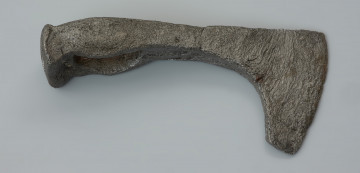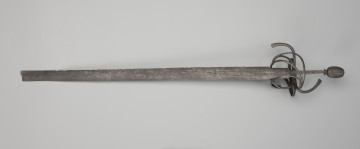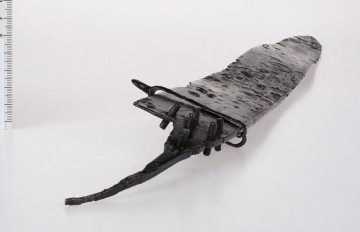
Battle axe (pickax)
701 — 900
National Museum in Szczecin
Part of the collection: Middle Ages
An iron axe found during dredging of the bed of the Western Oder in June 1939 at the village of Moczyły, in what is now the Police district, south of Szczecin. Information on the manner and circumstances of the discovery comes from the archives of the Archaeology Department of the National Museum (Muzeum Narodowe) in Szczecin. The pickaxe consists of two basic elements: a wooden axe and a blade mounted on it. In most cases, only the iron parts have survived to our times. The specimen from Moczyły has slender iron cabs, almost perpendicular to the vertical axis of the axe. The lumen of the cast, i.e., the place where the axe is set, is oval, and the axe has distinct, slightly rounded and lowered protuberances called whiskers. The point, the blunt part of the blade, is finished with a short, rectangular in cross-section thickening the so-called hammer. The blade of the axe has a slender neck, which gently expands to form a narrow, slightly asymmetrical and curved blade. Based on analogous specimens found in well-dated cultural layers, an axe handle from Moczyły can be dated to the 8th - 10th centuries.
Sławomir Słowiński
Author / creator
Dimensions
cały obiekt: height: 5.6 cm, width: 20.8 cm
Object type
axe, hatchet, weapon
Technique
forging
Material
iron
Origin / acquisition method
legal transfer
Creation time / dating
Creation / finding place
Owner
Muzeum Narodowe w Szczecinie
Identification number
Location / status

701 — 900
National Museum in Szczecin

1560 — 1610
National Museum in Szczecin

National Museum in Lublin
DISCOVER this TOPIC
Museum of King Jan III's Palace at Wilanów
DISCOVER this PATH
Educational path